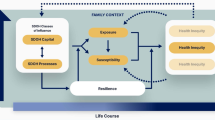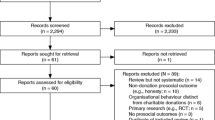Abstract
The fiscal regime implemented in Brazil with the constitutional amendment 95 (EC-95) of December 2016 froze primary expenditures for 20 years, including healthcare spending. Previous studies have estimated strong negative effects of this policy on the health of Brazilians. Although there has been a constant pressure to repeal EC-95, this policy is unlikely to be changed in the near future. Thus, there is also a need to take actions within its own terms in order to mitigate its harmful consequences on population health. Shedding light on the existing evidence about the impact of austerity on health, the present work discusses how decision-makers can use a formal framework of decision making in priority setting and resource allocation to tackle the amplified budgetary strain. Drawing on principles of Program Budgeting and Marginal Analysis (PBMA), efficiency can be improved by shifting spending from low-value to higher-value areas, avoiding the “across-the-board cut” caused by non-differential consideration of expenditures in a context of mismatched growth of demand and supply of healthcare. By evaluating opportunity costs of investment and disinvestment proposals on the basis of multiple criteria and marginal analysis, the Brazilian public healthcare system could obtain gains in value, achieving better performance and attenuating the relative decline in spending on health brought by an austerity scenario.


Similar content being viewed by others
References
Doniec K, Dall’Aba R, King L. Brazil’s health catastrophe in the making. The Lancet. 2018;392(10149):731–2. https://doi.org/10.1016/S0140-6736(18)30853-5.
World Population Prospects—Population Division—United Nations. 2020. https://population.un.org/wpp/. Accessed 7 Mar 2020.
Paim J, Travassos C, Almeida C, Bahia L, Macinko J. The Brazilian health system: history, advances, and challenges. The Lancet. 2011;377(9779):1778–977. https://doi.org/10.1016/S0140-6736(11)60054-8.
Viana AL, d’Avila A, Machado CV. Federative coordination and decentralization: Brazilian experience in health. Cienc Saude Coletiva. 2009;14(3):807–17. https://doi.org/10.1590/s1413-81232009000300016.
Castro MC, Massuda A, Almeida G, et al. Brazil’s unified health system: the first 30 years and prospects for the future. Lancet Lond Engl. 2019;394(10195):345–56. https://doi.org/10.1016/S0140-6736(19)31243-7.
Giovanella L, Escorel S, Lobato L de VC, Noronha J de C, Carvalho AI de. Políticas e sistema de saúde no Brasil. SciELO - Editora FIOCRUZ. 2012.
Vieira, FS; Benevides, RPS. Os Impactos Do Novo Regime Fiscal Para O Financiamento Do Sistema Único De Saúde E Para A Efetivação Do Direito À Saúde No Brasil. Brasília-DF: Ipea, 2016. (Nota técnica nº 28).
The World Bank, Inflation, consumer prices (annual %). [Data file]. Retrieved from https://data.worldbank.org/indicator/FP.CPI.TOTL.ZG?end=2019&locations=BR&name_desc=false&start=2015. Accessed 7 Mar 2020.
Volpe RA. Projeções Orçamentárias: Cenários para 2019–2023 no Contexto de Tetos de Gastos. Brasília-DF: Consultoria de Orçamentos e Fiscalização Financeira. (Estudo Técnico Número 25/2018). 2018.
Karanikolos M, Heino P, McKee M, Stuckler D, Legido-Quigley H. Effects of the global financial crisis on health in high-income oecd countries: a narrative review. Int J Health Serv Plan Adm Eval. 2016;46(2):208–40. https://doi.org/10.1177/0020731416637160.
Stuckler D, Basu S, Suhrcke M, Coutts A, McKee M. The public health effect of economic crises and alternative policy responses in Europe: an empirical analysis. Lancet Lond Engl. 2009;374(9686):315–23. https://doi.org/10.1016/S0140-6736(09)61124-7.
Williams C, Gilbert BJ, Zeltner T, Watkins J, Atun R, Maruthappu M. Effects of economic crises on population health outcomes in Latin America, 1981–2010: an ecological study. BMJ Open. 2016;6:1. https://doi.org/10.1136/bmjopen-2014-007546.
Schrecker T, Bambra C. How politics makes us sick: neoliberal epidemics. 2015 edition. Houndmills, Basingstoke, Hampshire ; New York, NY: Palgrave Macmillan. 2015.
Stuckler DB. The body economic. Toronto: HarperCollins Publishers Ltd; 2013.
Rasella D, Basu S, Hone T, Paes-Sousa R, Ocké-Reis CO, Millett C. Child morbidity and mortality associated with alternative policy responses to the economic crisis in Brazil: a nationwide microsimulation study. PLoS Med. 2018;15(5):e1002570. https://doi.org/10.1371/journal.pmed.1002570.
Rasella D, Hone T, de Souza LE, Tasca R, Basu S, Millett C. Mortality associated with alternative primary healthcare policies: a nationwide microsimulation modelling study in Brazil. BMC Med. 2019;17:1. https://doi.org/10.1186/s12916-019-1316-7.
Alfradique ME, de Bonolo PF, Dourado I, et al. Ambulatory care sensitive hospitalizations: elaboration of Brazilian list as a tool for measuring health system performance (Project ICSAP–Brazil). Cad Saude Publ. 2009;25(6):1337–499. https://doi.org/10.1590/s0102-311x2009000600016.
Malta DC, Duncan BB, de Barros MBA, et al. Fiscal austerity measures hamper noncommunicable disease control goals in Brazil. Ciênc Amp Saúde Coletiva. 2018;23(10):3115–222. https://doi.org/10.1590/1413-812320182310.25222018.
Choosing Wisely|Promoting conversations between providers and patients. 2020. https://www.choosingwisely.org/. Accessed 4 Apr 2020.
Choosing Wisely Canada. Choosing Wisely Canada. 2020. https://choosingwiselycanada.org/. Accessed 4 Apr 2020.
NICE Do not Do prompts. NICE. 2020. https://www.nice.org.uk/sharedlearning/nice-do-not-do-prompts. Accessed 4 Apr 2020.
Papanicolas I, Woskie LR, Orlander D, Orav EJ, Jha AK. The relationship between health spending and social spending in high-income countries: how does the US compare? Health Aff (Millwood). 2019;38(9):1567–75. https://doi.org/10.1377/hlthaff.2018.05187.
Mitton C, Dionne F, Donaldson C. Managing healthcare budgets in times of austerity: the role of program budgeting and marginal analysis. Appl Health Econ Health Policy. 2014;12(2):95–102. https://doi.org/10.1007/s40258-013-0074-5.
Mitton C, Donaldson C. Priority setting toolkit : guide to the use of economics in healthcare decision making (1). London, GB: John Wiley & Sons, Incorporated; 2009. https://site.ebrary.com/lib/alltitles/docDetail.action?docID=10158782. Accessed 18 Apr 2017.
Mitton C, Peacock S, Donaldson C, Bate A. Using PBMA in health care priority setting: description, challenges and experience. Appl Health Econ Health Policy. 2003;2(3):121–7.
Regier DA, Peacock S. Theoretical foundations of MCDA. In: Marsh K, Goetghebeur M, Thokala P, Baltussen R, editors. Multi-criteria decision analysis to support healthcare decisions. Cham: Springer International Publishing; 2017. p. 9–28. https://doi.org/10.1007/978-3-319-47540-0_2
Ruta DA, Donaldson C, Gilray I. Economics, public health and health care purchasing: the Tayside experience of programme budgeting and marginal analysis. J Health Serv Res Policy. 1996;1(4):185–93.
Goodwin E, Frew EJ. Using programme budgeting and marginal analysis (PBMA) to set priorities: reflections from a qualitative assessment in an English Primary Care Trust. Soc Sci Med. 2013;98:162–8. https://doi.org/10.1016/j.socscimed.2013.09.020.
Mitton C, Mackenzie J, Cranston L, Teng F. Priority setting in the provincial health services authority: case study for the 2005/06 planning cycle. Healthc Policy Polit Sante. 2006;2(1):91–106.
Dionne F, Mitton C, Smith N, Donaldson C. Evaluation of the impact of program budgeting and marginal analysis in Vancouver Island Health Authority. J Health Serv Res Policy. 2009;14(4):234–42. https://doi.org/10.1258/jhsrp.2009.008182.
Astley J, Wake-Dyster W. Evidence-based priority setting. Aust Health Rev Publ Aust Hosp Assoc. 2001;24(2):32–9.
Haas M, Viney R, Kristensen E, Pain C, Foulds K. Using programme budgeting and marginal analysis to assist population based strategic planning for coronary heart disease. Health Policy Amst Neth. 2001;55(3):173–86.
Smith N, Mitton C, Hiltz M-A, et al. A qualitative evaluation of program budgeting and marginal analysis in a Canadian pediatric tertiary care institution. Appl Health Econ Health Policy. 2016;14(5):559–68. https://doi.org/10.1007/s40258-016-0250-5.
Charles JM, Brown G, Thomas K, et al. Use of programme budgeting and marginal analysis as a framework for resource reallocation in respiratory care in North Wales, UK. J Public Health Oxf Engl. 2016;38(3):e352–e361361.
Edwards RT, Charles JM, Thomas S, et al. A national programme budgeting and marginal analysis (PBMA) of health improvement spending across Wales: disinvestment and reinvestment across the life course. BMC Public Health. 2014;14:837. https://doi.org/10.1186/1471-2458-14-837.
Mitton C, Dionne F, Damji R, Campbell D, Bryan S. Difficult decisions in times of constraint: criteria based resource allocation in the Vancouver Coastal Health Authority. BMC Health Serv Res. 2011;11:169. https://doi.org/10.1186/1472-6963-11-169.
Wiseman V, Mitton C, Doyle-Waters MM, et al. Using economic evidence to set healthcare priorities in low-income and lower-middle-income countries: a systematic review of methodological frameworks. Health Econ. 2016;25:140–61. https://doi.org/10.1002/hec.3299.
Cromwell I, Peacock SJ, Mitton C. ‘Real-world’ health care priority setting using explicit decision criteria: a systematic review of the literature. BMC Health Serv Res. 2015;15:164. https://doi.org/10.1186/s12913-015-0814-3.
Hipgrave DB, Alderman KB, Anderson I, Soto EJ. Health sector priority setting at meso-level in lower and middle income countries: Lessons learned, available options and suggested steps. Soc Sci Med. 2014;102:190–200. https://doi.org/10.1016/j.socscimed.2013.11.056.
Mitton C, Seixas BV, Peacock S, Burgess M, Bryan S. Health technology assessment as part of a broader process for priority setting and resource allocation. Appl Health Econ Health Policy. 2019;17(5):573–6. https://doi.org/10.1007/s40258-019-00488-1.
Lima SGG, de Brito C, de Andrade CJC. Health technology assessment in Brazil—an international perspective. Cienc Saude Coletiva. 2019;24(5):1709–22. https://doi.org/10.1590/1413-81232018245.17582017.
Pereira VC, Barreto JOM, da Neves FAR. Health technology reassessment in the Brazilian public health system: analysis of the current status. PLoS ONE. 2019;14(7):e0220131. https://doi.org/10.1371/journal.pone.0220131.
Porter ME. What is value in health care? N Engl J Med. 2010;363(26):2477–81. https://doi.org/10.1056/NEJMp1011024.
Author information
Authors and Affiliations
Contributions
BVS conceptualized the work, carried out the literature review, drafted the paper and reviewed the final version; CM supervised the development of the work and reviewed the final version.
Corresponding author
Ethics declarations
Funding
No funding was received for carrying out this study.No funding was received for carrying out this study.
Conflict of interest
Brayan V. Seixas and Craig Mitton declare no conflicts of interest in pursuing the current work.
Rights and permissions
About this article
Cite this article
Seixas, B.V., Mitton, C. Using a Formal Strategy of Priority Setting to Mitigate Austerity Effects Through Gains in Value: The Role of Program Budgeting and Marginal Analysis (PBMA) in the Brazilian Public Healthcare System. Appl Health Econ Health Policy 19, 9–15 (2021). https://doi.org/10.1007/s40258-020-00591-8
Published:
Issue Date:
DOI: https://doi.org/10.1007/s40258-020-00591-8




